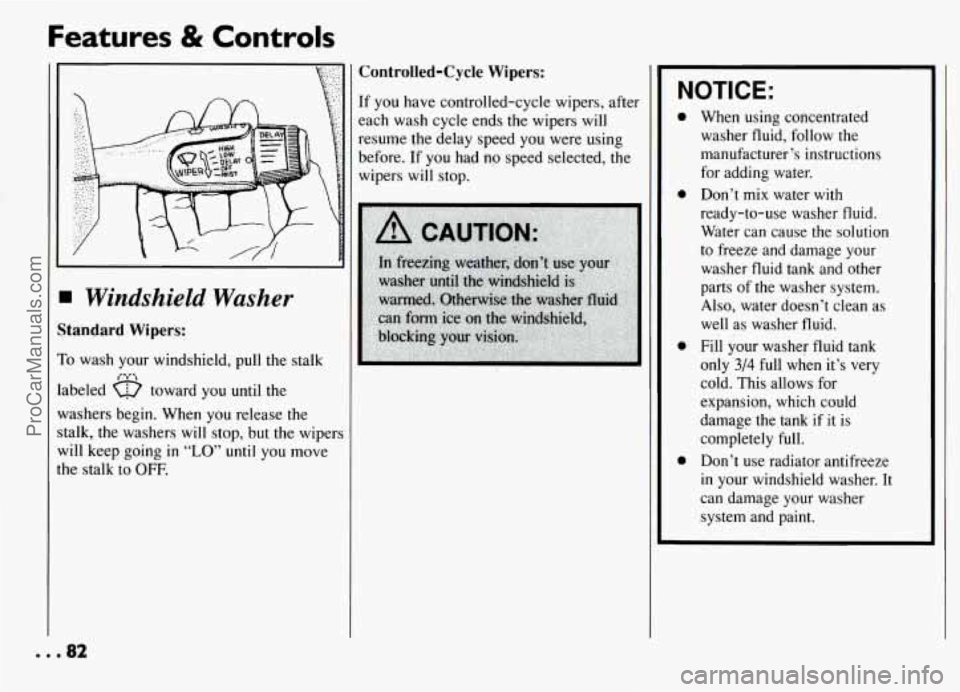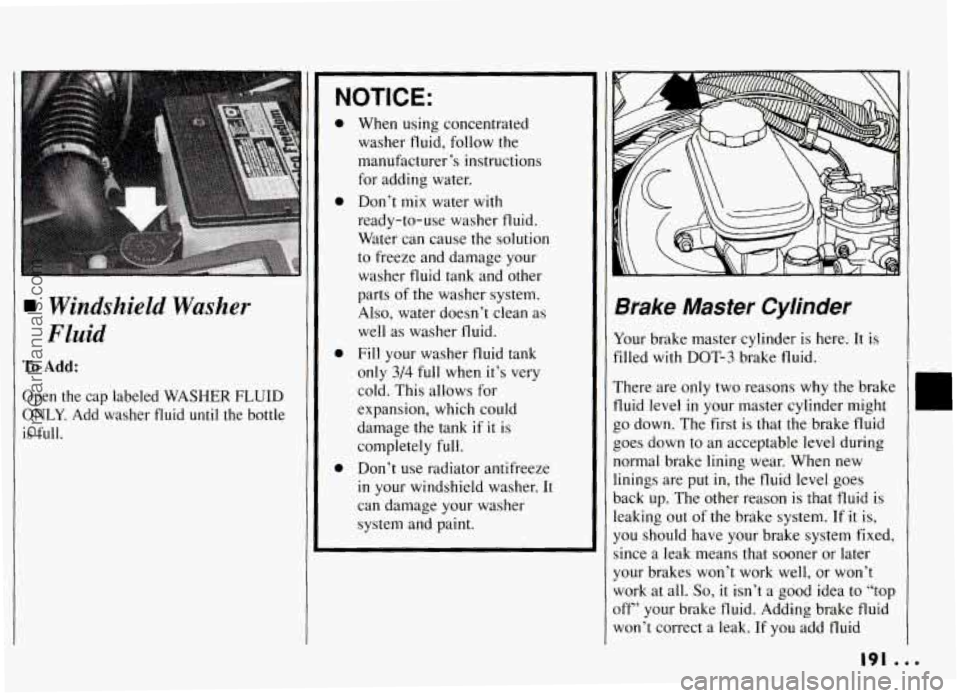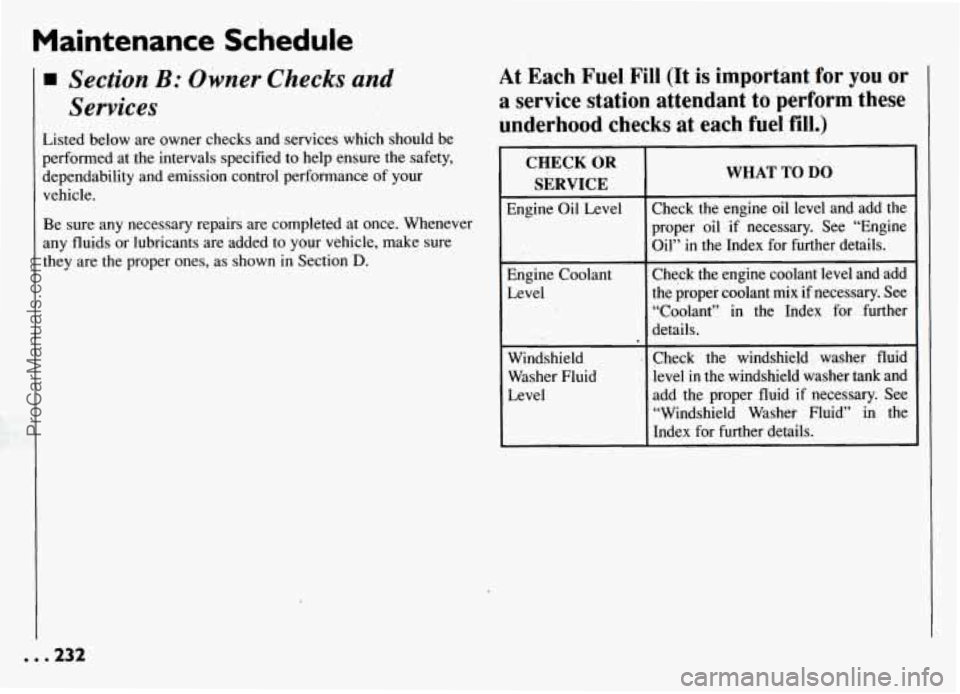Page 83 of 274

Features & Controls
Controlled-Cycle Wipers:
I Windshield Washer
itandard Wipers:
’0 wash your windshield, pull the stalk
abeled a toward you until the
Y-ashers begin. When you release the
talk, the washers will stop, but the wipers
vi11 keep going in “LO” until you move
he stalk to OFF.
,-i;
If you have controlled-cycle wipers, after
each wash cycle ends the wipers
will
resume the delay speed you were using
before. If you had no speed selected, the
wipers
will stop. ~
NOTICE:
0
0
0
0
When using concentrated
washer fluid, follow the
manufacturer’s instructions
for adding water.
Don’t
mix water with
ready-to-use washer fluid. Water can cause the solution
to freeze and damage your
washer fluid tank and other
parts of the washer system.
Also, water doesn’t clean as
well as washer fluid.
Fill your washer fluid tank
only
314 full when it’s very
cold. This allows for
expansion, which could
damage the tank
if it is
completely full.
Don’t use radiator antifreeze
in your windshield washer. It
can damage your washer
system and
paint.
..e82
ProCarManuals.com
Page 134 of 274

At the entrance there is usually a ramp
that leads to the freeway. If you have a
clear view of the freeway as you drive
along
the entrance ramp, you should
begin to check traffic. Try to determine
where you expect
to blend with the flow.
Try to merge into the gap at close
to the
prevailing speed. Switch on your turn signal, check your mirrors and glance
over your shoulder as often as necessary.
Try to blend smoothly with the traffic
flow.
Once you are on the freeway, adjust your
speed to the posted limit or to the
prevailing rate if it’s slower. Stay in the
right lane unless you want to pass.
Before changing lanes, check your
mirrors. Then use your turn signal.
Just before you leave the lane, glance
quickly over your shoulder to make sure
there isn’t another vehicle in your “blind”
spot.
Once you are moving on the freeway,
make certain you allow a reasonable following distance. Expect to move
slightly slower at night.
When you want to leave the freeway,
move to the proper lane well
in advance.
If you-miss your exit do not; under any
circumstances, stop and back
up. Drive on
to the next exit.
The exit ramp can be curved, sometimes
quite sharply.
The exit speed is usually posted.
Reduce your speed according to your
speedometer, not to your sense of motion.
After driving for any distance at higher
speeds, you may tend to think you are
going slower than you actually are.
Before Leaving on a
Long Trip
Make sure you’re ready. Try to be well
rested. If
you must start when you’re not
fresh
-- such as after a day’s work --
don’t plan to make too many miles that
first part of the journey. Wear comfortable
clothing and shoes you can easily drive
in.
Is your vehicle ready for a long trip? If
you keep it serviced and maintained, it’s
ready to go. If it needs service, have it
done before starting out. .Of course, you’ll
find experienced and able service experts
in Pontiac dealerships all across North
America. They’ll be ready and willing to
help if you need it.
Here are some things you can check
before a trip:
0
0
0
0
0
0
0
Windshield Washer Fluid: Is the
reservoir full? Are all windows clean
inside and outside?
Wiper Blades: Are they in good
shape?
Fuel, Engine Oil. Other Fluids: Have
you checked all levels?
Lights:’
Are they all working? Are the
lenses clean?
Tires: They are vitally important to a
safe, trouble-free trip. Is the tread
good enough for long-distance
driving?
Are the tires all inflated to
the recommended pressure?
Weather Forecasts: What’s the
weather outlook along your route?
Should you delay your trip a short
time to avoid a major storm system?
Maps: Do you have up-to-date maps?
133...
ProCarManuals.com
Page 137 of 274
Your Driving and the Road
Winter Driving
Here are some tips for winter driving:
Have your Pontiac in good shape for
winter. Be sure your engine coolant
mix is correct.
0 You may want to put winter
emergency supplies in your trunk.
Include an ice scraper, a small brush or
broom, a supply
of windshield washer
fluid, a rag, some winter outer clothing, a
small shovel, a flashlight, a red cloth, and
a couple of reflective warning triangles.
And, if you will be driving under severe
conditions, include a small bag of sand, a
piece of old carpet or a couple
of burlap
bags
to help provide traction. Be sure you
properly secure these items
in your
vehicle.
Driving on Snow or Ice
Most of the time, those places where your
tires meet the road probably have good
traction.
However, if there is snow or ice between
your tires and the road, you can have a
very slippery situation. You’ll have a lot
less traction or “grip” and will need to be
very careful.
. . . 136
ProCarManuals.com
Page 178 of 274
2.3L Quad OHC and Quad
4 Engines (CODES 3,
D AND A)
When you open the hood, you'll see:
1. Automatic Transaxle Dipstick
(if'equipped)
2. Brake Fluid Reservoir
3. Air Cleaner
4. Hydraulic Clutch Fluid Reservoir
(if so equipped)
5. Battery
6. Windshield Washer Fluid Reservoir
7. Power Steering Fluid Reservoir
B. Engine Oil Fill Cap, Engine Oil
Dipstick
3. Engine Coolant Surge Tank
ProCarManuals.com
Page 179 of 274
Service & Appearance Care
3.IL V6 Engine (CODE M)
When you open the hood, you’ll see:
1. Power Steering Fluid Reservoir
2. Automatic Transaxle Fluid Dipstick
3. Brake Fluid Reservoir
4. Air Cleaner
5. Battery
6. Windshield Washer Fluid Reservoir
7. Engine Oil Dipstick
8. Engine Oil Fill Cap
9. Engine Coolant Surge Tank
ProCarManuals.com
Page 192 of 274

NOTICE:
1 Windshield Washer
Fluid
To Add:
Open the cap labeled WASHER FLUID
ONLY. Add washer fluid until the bottle
is full.
a
e
a
a
When using concentrated
washer fluid, follow the
manufacturer’s instructions
for adding water.
Don’t
mix water with
ready-to-use washer fluid.
Water can cause the solution
to freeze and damage your
washer fluid tank and other
parts of the washer system.
Also, water doesn’t clean as
well as washer fluid.
Fill your washer
fluid tank
only
3/4 full when it’s very
cold. This allows for
expansion, which could
damage the tank if
it is
completely
full.
Don’t use radiator antifreeze
in your windshield washer. It
can damage your washer
system and paint.
Brake Master Cylinder
Your brake master cylinder is here; It is
filled
with DOT-3 brake fluid.
There are only two reasons why the brake
fluid level
in your master cylinder might
go down. The first is that the brake fluid
goes down to an acceptable level during
normal brake lining wear. When new
linings are put
in, the fluid level goes
back up. The other reason
is that fluid is
leaking out of the brake system.
If it is,
you should have your brake system fixed,
since a leak means that sooner or later
your brakes won’t work well, or won’t
work at all.
So, it isn’t a good idea to “top
off’ your brake fluid. Adding brake fluid
won’t correct
a leak. If you add fluid
191 ...
ProCarManuals.com
Page 233 of 274

Maintenance Schedule
Section B: Owner Checks and
Services
Listed below are owner checks and services which should be
performed at the intervals specified to help ensure the safety,
dependability and emission control performance of your
vehicle.
Be sure any necessary repairs are completed at once. Whenever
any fluids or lubricants are added to your vehicle, make sure
they are the proper ones, as shown in Section
D.
At Each Fuel Fill (It is important for you or
a service station attendant to perform these
underhood checks at each fuel fill.)
CHECK OR
SERVICE
Engine Oil Level
Engine Coolant
Level
Windshield
Washer Fluid
Level
WHAT TO DO
Check the engine oil level and add the
proper oil
if necessary. See “Engine
Oil”
in the Index for further details.
Check the engine coolant level and add
the proper coolant mix if necessary. See
“Coolant” in the Index for further
details.
Check the windshield washer fluid
level in the windshield washer tank and
add the proper fluid
if necessary. See
“Windshield Washer Fluid” in the
Index for further details.
ProCarManuals.com
Page 240 of 274
USAGE
Clutch Linkage
Pivot Points
Chassis
Lubrication and
Fuel Filler Door
and Striker
Plunger
Windshield
Washer Solvent
Hdod Latch
Assembly
a. Pivots and
b. Release Pawl
Spring Anchor
FLUIDlLUBRICANT ---I
Engine oil.
I
Chassis lubricant (GM Part No.
1052497 or equivalent) or lubricant
meeting requirements
of NLGI Grade
2, Category LB or GC-LB.
GM Optikleen@ Washer ~~ Solvent
Part
NO. 10515 15) or equivalent.
a. Engine oil.
b. Chassis lubricant meeting
requirements of NLGI Grade 2,
Category LB (GM Part
No.
1052497 or equivalent) or GC-LB.
Hinges, Rear
Weatherstrips
I FLUIDlLUBRICANT ~~~~~~~~ ~
Engine
oil or Lubriplate Lubricant (GM
Part No. 1050109).
Dielectric Silicone Grease (GM Part
No. 12345579 or equivalent).
See “Replacement Parts” in the Index for recommended
replacement filters, valves and spark plugs.
239
ProCarManuals.com